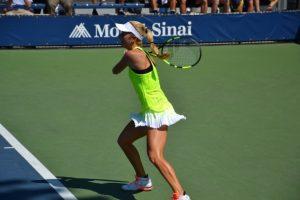We may earn money or products from the companies mentioned in this post.
Introduction

Have you ever wondered what it takes to be considered a 40 tennis player? In the world of tennis, skill levels are categorized to ensure fair competition and provide players with a clear understanding of their abilities The National Tennis Rating Program (NTRP) plays a vital role in determining these skill levels and is highly regarded within the tennis community
Definition of a 40 tennis player
In the NTRP rating system, a 40 tennis player is classified as an intermediate-level player who possesses solid fundamentals and has developed consistency in their shots These players demonstrate improved court awareness, strategic thinking, and the ability to execute various strokes effectively
To put it simply, a 40 player is someone who can consistently hit groundstrokes with depth and control, maneuver around the court efficiently, display versatility in their shot selection, and exhibit proficiency in both singles and doubles play
Importance of the NTRP rating system for players and tournaments
The NTRP rating system holds significant importance for both players and tournament organizers alike For players, having an accurate NTRP rating allows them to find suitable opponents for competitive matches that provide challenging yet enjoyable experiences on the court
Additionally, tournaments often use NTRP ratings as a means of ensuring fair competition by grouping participants based on their skill levels This helps create balanced matches where players can showcase their abilities without feeling overwhelmed or undermatched
How to determine your skill level

Self-assessment guidelines
Determining your own skill level can be subjective at times, but there are some guidelines you can follow to gain a better understanding of where you stand in terms of tennis proficiency Reflect on your abilities in various aspects of the game, such as stroke consistency, shot selection, court positioning, and overall match performance
Consider factors like the level of competition you feel comfortable playing against and whether you can consistently execute shots with control and accuracy It is also helpful to seek feedback from more experienced players or coaches who can provide objective assessments of your skill level
Official NTRP rating process
If you’re looking for an official NTRP rating, participating in USTA-sanctioned events or contacting your local tennis association is a great way to start By competing in tournaments or matches specifically designated for NTRP ratings, certified raters will evaluate your gameplay and assign you a precise rating based on their observations
This official NTRP rating not only helps you gauge your current skill level but also opens up opportunities to compete against similarly skilled players in organized leagues and tournaments
Characteristics of a 40 Tennis Player

Tennis is a game that requires a unique combination of technical and tactical skills A 40 tennis player possesses a level of proficiency that sets them apart from beginners and intermediate players Let’s delve into the key characteristics that define a 40 tennis player
Technical Skills
At the heart of any skilled tennis player are their technical abilities In terms of groundstrokes, a 40 player demonstrates consistency and depth in both their forehand and backhand shots, allowing them to keep the ball in play with precision
But it doesn’t stop there – a 40 player possesses an arsenal of shot variations, including topspin, slice, and flat shots This versatility enables them to adapt to different match situations and confound opponents with unexpected shot selections
Serve and Return Techniques
The serve is often considered the most crucial shot in tennis, and a 40 player understands this well They have mastered the art of placement and power on their first serves, effectively keeping opponents off balance and gaining an advantage right from the start
In addition to their first serves, a 40 player also displays consistency on their second serves, making it difficult for opponents to capitalize on weak returns Their anticipation skills come into play when returning serves, allowing them to react swiftly and execute well-placed shots
Tactical Skills
A true mark of a 40 tennis player lies in their ability to strategize against different opponents effectively They possess an astute awareness of opponents’ strengths and weaknesses, enabling them to develop tailored strategies to exploit vulnerabilities or neutralize threats
Adaptability is another key aspect of a 40 player’s tactical skills They are quick to adjust their game plan during matches based on the progression and changing circumstances on the court This ability to think on their feet sets them apart from lesser-skilled players
Court Positioning
Proper court positioning is crucial in tennis, and a 40 player understands this concept well During baseline rallies, they are adept at finding the optimal position on the court to execute shots effectively while maintaining balance and control
In doubles matches, a 40 player’s net play is particularly impressive They display excellent reflexes, making it difficult for opponents to find openings at the net Their ability to anticipate and react quickly ensures that they can make impactful plays that swing the momentum in their favor
Overall, the characteristics of a 40 tennis player encompass both technical finesse and tactical brilliance It is this combination that propels them to excel in their game and compete at a higher level
Challenges faced by a 40 player and how to overcome them

Being a 40 tennis player comes with its own set of challenges Whether you’re striving to improve your physical conditioning, mental toughness, or technique refinement, there are ways to overcome these obstacles and elevate your game to the next level
Physical conditioning
1 Improving strength, endurance, speed, and flexibility:
Physical fitness is crucial for any tennis player looking to excel on the court As a 40 player, you might find yourself needing extra work in areas such as strength, endurance, speed, or flexibility Incorporating targeted exercises and drills into your training routine can help you address these specific needs
Mental toughness
1 Handling pressure situations:
Tennis matches can be mentally challenging, especially when the stakes are high Developing strategies to stay composed under pressure is essential for a 40 player aiming for success Techniques such as deep breathing exercises or visualization can help calm nerves and maintain focus during critical moments
2 Staying focused during high-stakes matches:
Maintaining concentration throughout an entire match can be demanding but is vital for consistent performance as a 40 player Creating mental triggers like repeating positive affirmations or setting short-term goals during play can help you stay engaged without getting overwhelmed by the magnitude of the situation
Technique refinement
1Working with coaches or taking lessons to fine-tune strokes:
No matter how skilled you are at the game, refining your tennis technique should always be a priority as a 40 player aspiring for progress
Working closely with experienced coaches or taking lessons can provide valuable insights and guidance to fine-tune your strokes, footwork, and overall mechanics
.Progressing from 40 to higher levels:
Achieving a higher level of play is a common goal for many 40 players looking to challenge themselves further Here are a few strategies that can help you progress:
Setting realistic goals:
Setting achievable milestones will keep you motivated and give you direction in your journey towards advancing beyond the 40 level
Practicing with higher-rated players:
Surrounding yourself with more skilled opponents can provide invaluable learning opportunities and expose you to different playing styles, helping you raise your own game
Participating in competitive match play:
Competing in tournaments or joining leagues against stronger opponents will test your abilities and push you to adapt and improve as a player
Tips for Success as a 40 Tennis Player

Being a successful 40 tennis player requires dedication, skill development, physical fitness, and a strong mental approach to the game Here are some tips that can help you elevate your game and reach new heights on the tennis court
Commitment to Skill Development
To excel as a 40 tennis player, it’s crucial to have a strong commitment to skill development This means regular practice sessions and dedicating time to mastering stroke techniques
-
Regular Practice Sessions:
Consistency is key when it comes to improving your skills as a tennis player Make sure you set aside dedicated time for practice sessions, whether it’s hitting with a partner or working with a coach -
Emphasis on Mastering Stroke Techniques:
A solid foundation of stroke techniques is essential for success in tennis Focus on perfecting your forehand, backhand, volleys, serves, and other shots through repetitive practice and expert guidance
Physical Fitness and Injury Prevention
In addition to skill development, maintaining physical fitness and preventing injuries are vital aspects of becoming a top-notch 40 tennis player
-
Proper Warm-up and Cool-down Routines:
Before every match or training session, make sure you warm up your muscles with dynamic stretches and exercises Similarly, cool down afterward with static stretches to prevent muscle soreness and injury -
Balanced Training Regimens:
Incorporate strength training exercises to build power in your shots, cardio workouts for endurance on the court, and flexibility exercises to improve agility and prevent injuries
Mental Approach to the Game
Having a strong mental approach is often what sets successful tennis players apart from the rest Here are some key points to focus on:
-
Focus on Personal Growth:
Rather than comparing yourself to others, concentrate on your own growth and improvement as a player Set personal goals and work towards achieving them -
Embrace a Growth Mindset:
Learn from losses and setbacks instead of letting them discourage you A growth mindset allows you to see challenges as opportunities for growth and keeps you motivated to keep pushing forward
By following these tips, you can enhance your skills, stay physically fit, and develop the right mindset that will help you succeed as a 40 tennis player Remember, success in tennis is not only about winning matches but also about continuous improvement and enjoying the game!
Useful Links

Why is Tennis Scored the Way it is? (Tennis Scoring History)
Digging Out of the Holes of 0-40 and 15-40
How To Play Tennis | Rules of Sport
In tennis, does anybody know why the scoring goes 15 to 30 …
Tennis Rules
Scoring with tactics: Why even the best tennis players lose …
How to Bet on Tennis
Pepperstone ATP Rankings (Singles)
Tennis Scoring 101
Scores and Serving Side – Tennis
What is a score of 40 40 in tennis called? – stalbanstennis.co.uk
Points and rules
Top 10 Singles Strategies for Players Over 40 – YouTube
Tennis Glossary
Best Gifts For Tennis Players 2023 – 50 Gift Ideas – Perfect …
US Open 101: a USOpen.org guide to how tennis works.
What Does ‘Ad’ Mean in Tennis?
Top five oldest players to win ATP Masters 1000 title






